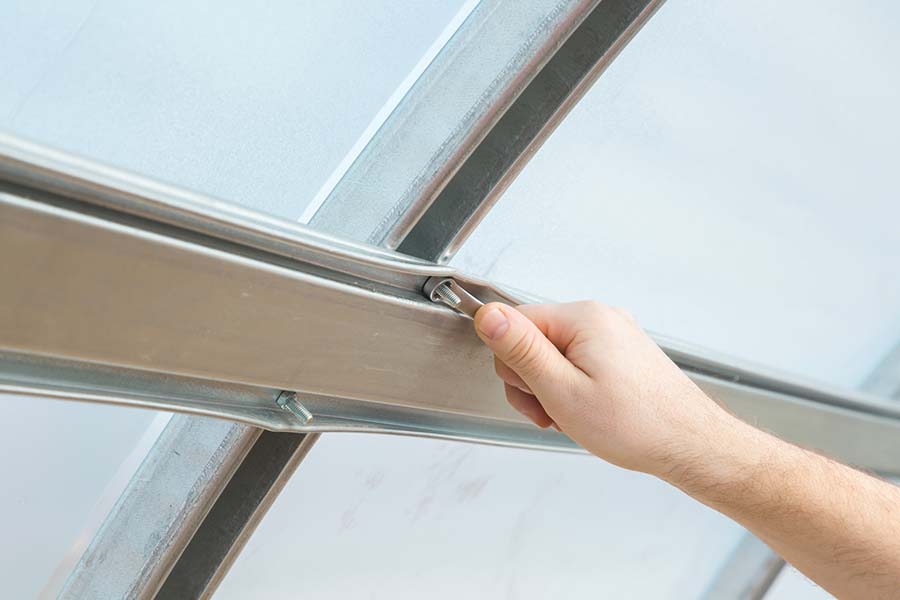You’ve planned for a powerful geothermal engine and a well-insulated structure, but the entire system’s performance now hinges on one final, critical choice: the clear skin that covers the frame.
The greenhouse covering is the single component that determines how much free solar energy gets in and how much of the valuable heat you’ve generated stays in. Skimping on your covering is not a shortcut; it’s a critical failure point that can undermine your entire investment. A cheap, inefficient covering wastes the power of your geothermal system, forcing it to work overtime and erasing the very energy savings you invested to achieve. Worse, it cripples your growing season by starving your plants of light.
A high-performance geothermal system, a well-insulated structure, and a high-quality covering are the three essential pillars of an efficient greenhouse. A failure in any one of these components will compromise the other two, undermining your investment and your entire year-round growing season.
The Big Three: What to Look for in a Greenhouse Covering
When you start comparing greenhouse coverings, you’ll be hit with a lot of technical specs. It’s easy to get lost in the numbers, but for a high-performance geothermal greenhouse, there are really only three metrics that matter. Understanding these “big three” will allow you to cut through the noise and choose a covering that maximizes your investment.
Light Transmittance: The Raw Fuel for Growth
This is the most straightforward metric: what percentage of visible light actually passes through the material and gets to your plants? For a greenhouse in a cold climate with short winter days, maximizing light transmittance is critical.
Every percentage point matters. A covering with 85% visible light transmittance lets in significantly more of the sun’s precious, growth-fueling energy than one with 75% transmittance. This number is the raw horsepower of your greenhouse, and a higher number is always better.
Haze/Diffusion: Spreading the Light Around
While transmittance is about the quantity of light, haze or diffusion is about the quality of that light. A material with a high haze factor scatters the light as it passes through, rather than letting it travel in a straight beam.
This is a huge advantage. Instead of harsh, direct sunlight that can scorch the tops of your plants while leaving the lower leaves in shadow, diffused light bathes the entire plant in a soft, even glow. This scattered light penetrates deeper into the plant canopy, reducing shadows and allowing more of the plant’s leaves to photosynthesize efficiently. For a greenhouse with dense plantings, a high haze factor (ideally above 80%) leads to healthier, more even growth.
Durability: Toughness Against the Elements
Your greenhouse covering is your first and last line of defense against wind, snow, and hail. A material that gets brittle in the cold, tears easily, or degrades quickly under UV light is a poor investment that will need to be replaced frequently.
This is where clear Reinforced Polyethylene (RPE) stands out. The internal woven “scrim” gives it exceptional tear and puncture resistance compared to standard, non-reinforced films. A high-quality RPE covering is built to withstand heavy snow loads and high winds for years, providing a durable, reliable envelope that protects your investment and your crops.
Choosing Your Skin: The Main Contenders
When it comes to choosing the skin for your greenhouse, there’s no single “best” answer—like many things in life, it’s a balancing act. The right choice for your project will be a trade-off between your budget, your climate, and your performance goals. We’ll break down the pros and cons of the three primary contenders: traditional glass, modern polycarbonate panels, and high-tech polyethylene films.
Glass: The OG Material
From the early 18th century, glass has been the dominant material for greenhouse covering, and it remains the traditional gold standard for good reason. Modern glass offers unmatched clarity and, absent direct physical damage, has a very long lifespan. Let’s consider its primary advantages:
Highest Light Transmission
High-quality glass offers the best light transmission of any commonly available material (often over 90%), allowing maximum sunlight to reach your plants.
Very Long Lifespan
Unlike plastics, glass will not degrade or turn yellow from extended UV exposure and can last for 30 years or more.
Looks Great
For many, the classic aesthetic of a glass greenhouse is a significant, if not defining, advantage.
Of course, glass greenhouses are far from the perfect solution, and their disadvantages can be significant in extreme climates.
Poor Insulation
A single pane of glass has very poor insulating properties, allowing rapid heat loss. Achieving good insulation with glass requires expensive double- or triple-pane units—the same types of windows you install in your home or office building, but writ large.
Fragile and Heavy
Glass is vulnerable to breaking from hail or impacts, and its significant weight requires a much stronger and more expensive structural frame than lighter alternatives.
Polycarbonate: The Tough Insulator
Polycarbonate is a rigid, impact-resistant plastic, often sold in twin-wall or multi-wall panels. The multi-layer structure significantly improves its insulating ability and conveys some other significant advantages.
Excellent Insulation
The insulating effect of the air pockets in multi-wall polycarbonate panels provides excellent insulation, which dramatically reduces heating costs, an enormous advantage in a cold climate.
Extremely Durable
As a plastic, polycarbonate is virtually unbreakable, thanks to its exceptional impact resistance, making it ideal for areas with heavy snow or hail.
Good Light Diffusion
Polycarbonate’s multi-wall structure is a natural diffuser, which spreads light more evenly throughout the greenhouse and prevents the scorching associated with focused light.
Naturally, these advantages are balanced by some weaknesses:
Lower Light Transmission
By its nature, polycarbonate will always transmit less light than glass (typically in the 80-85% range).
Degrades Over Time
Even with modern protective UV coatings, polycarbonate will slowly degrade and develop a yellow tint over time. Yellowing reduces light transmission considerably, and the associated degradation leaves the material more vulnerable to damage. Plan on replacing the whole exterior every 10-15 years.
Polyethylene Films: The Flexible Workhorse
Polyethylene is the most common (and broadest) category of greenhouse covering, but not all PE films are created equal. The market ranges from simple, inexpensive single-layer plastics to highly engineered, multi-layer reinforced materials. To help you make an informed choice, we’ll need to break them down into two distinct classes.
Standard Polyethylene Films
This is the basic, non-reinforced plastic film often sold in hardware stores. It’s an economical choice for temporary structures or seasonal high tunnels. Here are some of its strengths:
- Affordable: Basic polyethylene film is widely available and very reasonably priced.
- Flexible: By its nature, polyethylene film is highly flexible, making it easy to install over simple frames like hoop houses.
And here are some of its weaknesses:
- Short Lifespan: Basic polyethylene has a lifespan of only about 1-4 years.
- Low Durability: The non-reinforced film has low puncture and tear resistance and is highly vulnerable to wind and UV degradation.
Advanced, Reinforced Polyethylene (RPE) Films
These modern engineered films solve the durability problems of their more basic cousins. By incorporating specialized coatings and a woven reinforcement scrim, clear reinforced polyethylene offers a dramatic leap in performance.
Best of Both Worlds
Clear RPE has all the benefits of a flexible film (easy to install, conforms to any shape) along with exceptional strength, puncture resistance, and a much longer lifespan. It does have a higher upfront cost than standard, non-reinforced films. Still, it provides a durable, high-performance covering without the high initial investment and heavy structural requirements of rigid glass or polycarbonate panels.
The significant downsides of standard polyethylene—its short lifespan and vulnerability to damage—are precisely the problems that a high-performance, clear RPE film is designed to solve. Let’s look into its unique characteristics.
The RPE Advantage: The Benefits of Reinforced Polyethylene
High-performance, clear Reinforced Polyethylene (RPE) was engineered to provide the “best of both worlds”—combining the flexibility and light weight of a film with the durability of a more rigid material. By embedding a woven reinforcement scrim and adding specialized coatings, clear RPE offers a unique set of advantages for a high-performance geothermal greenhouse.
Superior Strength and Longevity
The internal woven scrim is the key to RPE’s exceptional puncture and tear resistance, making it far more durable than standard, non-reinforced films. This strength allows it to withstand high winds and heavy snow loads, giving it a much longer lifespan and making it a smarter long-term investment.
High Light Transmission
Unlike polycarbonate, high-quality clear RPE films can offer excellent light transmission, with some products allowing 82-85% of visible light to pass through. This ensures your plants get the maximum amount of solar energy, which is especially critical during the short, dark days of winter.
Advanced Coatings
Modern RPE films often include high-tech coatings that solve common greenhouse problems:
Anti-Condensate Coating
This prevents water droplets from forming on the inside of the covering. This not only stops water from dripping on your plants (which can cause disease) but also improves light transmission, as a solid sheet of condensation can block a significant amount of light.
Sulfur Resistance
For organic growers who may use sulfur as a fungicide or pesticide, this coating is essential. Sulfur can rapidly degrade standard polyethylene, but a resistant coating ensures the film’s longevity.
Looking Ahead
You now have a complete picture of the three critical pillars of a successful geothermal greenhouse: the heating and cooling engine, the insulated structure, and the high-performance covering. With the technical and design choices laid out, the final piece of the puzzle is the bottom line.
So, what does all of this cost? And how do you analyze the return on such a significant investment? The next chapter tackles the economics of geothermal greenhouses, from upfront costs and long-term payback to the financial incentives that can help make your project a reality.




